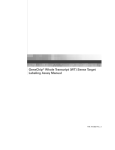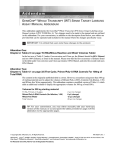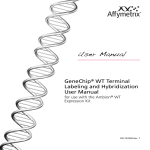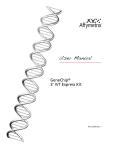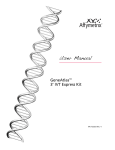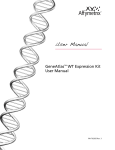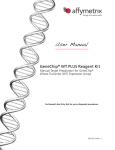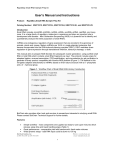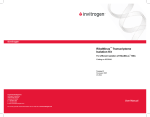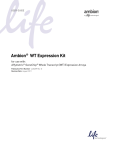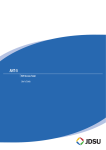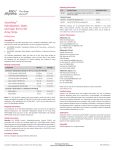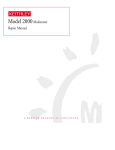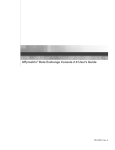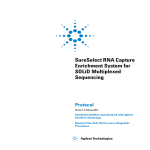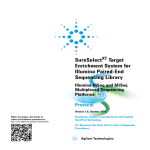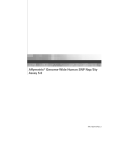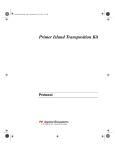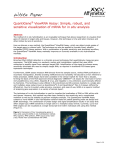Download User Manual, GeneChip® Whole Transcript WT
Transcript
User Manual GeneChip® Whole Transcript (WT) Sense Target Labeling Assay P/N 701880 Rev. 5 For research use only. Not for use in diagnostic procedures. Trademarks Affymetrix®, GeneChip®, , HuSNP®, GenFlex®, Flying Objective™, CustomExpress®, CustomSeq®, NetAffx™, Tools To Take You As Far As Your Vision®, The Way Ahead™, Powered by Affymetrix™, GeneChipcompatible™, Command Console™ , Genotyping Console™ and GeneTitan™ are trademarks of Affymetrix, Inc. All other trademarks are the property of their respective owners. Limited License Subject to the Affymetrix terms and conditions that govern your use of Affymetrix products, Affymetrix grants you a non-exclusive, non-transferable, non-sublicensable license to use this Affymetrix product only in accordance with the manual and written instructions provided by Affymetrix. You understand and agree that, except as expressly set forth in the Affymetrix terms and conditions, no right or license to any patent or other intellectual property owned or licensable by Affymetrix is conveyed or implied by this Affymetrix product. In particular, no right or license is conveyed or implied to use this Affymetrix product in combination with a product not provided, licensed, or specifically recommended by Affymetrix for such use. Patents Arrays: Products may be covered by one or more of the following patents and/or sold under license from Oxford Gene Technology: U.S. Patent Nos. 5,445,934; 5,700,637; 5,744,305; 5,945,334; 6,054,270; 6,140,044; 6,261,776; 6,291,183; 6,346,413; 6,399,365; 6,420,169; 6,551,817; 6,610,482; 6,733,977; and EP 619 321; 373 203 and other U.S. or foreign patents. Use of the GeneChip® WT cDNA Synthesis and Amplification Kit in accordance with the instructions provided is accompanied by a limited license to U.S. Patent Nos. 5,716,785; 5,891,636; 6,291,170; and 5,545,522. Users who do not purchase this Kit may be required to obtain a license under these patents or to purchase another licensed kit. Reagent products may also be covered by one or more of the following patents: U.S. Patent Nos. 6,864,059. Copyright ©2005-2009 Affymetrix Inc. All rights reserved. Contents Chapter 1 Overview . . . . . . . . . . . . . . . . . . . . . . . . . . . . . . . . . . . . . . . . . . .1 Whole Transcript Sense Target Labeling Assay Schematic . . . . . . . . . . . . . . 3 Materials . . . . . . . . . . . . . . . . . . . . . . . . . . . . . . . . . . . . . . . . . . . . . . . . . . 4 Necessary Reagents . . . . . . . . . . . . . . . . . . . . . . . . . . . . . . . . . . . . . . . . . 4 Miscellaneous Reagents . . . . . . . . . . . . . . . . . . . . . . . . . . . . . . . . . . . . . 7 Miscellaneous Supplies . . . . . . . . . . . . . . . . . . . . . . . . . . . . . . . . . . . . . . 8 Instruments . . . . . . . . . . . . . . . . . . . . . . . . . . . . . . . . . . . . . . . . . . . . . . . 9 Suggested Workflow . . . . . . . . . . . . . . . . . . . . . . . . . . . . . . . . . . . . . . . . 10 Chapter 2 rRNA Reduction and Preparation of Total RNA with Diluted Poly-A RNA Controls . . . . . . . . . . . . . . . . . . . . . . . . . . . . . . . . .11 Procedure A: Preparation of Dilutions of Poly-A RNA Controls . . . . . . . . . . Procedure B: Preparation of Hybridization Buffer with Betaine . . . . . . . . . . Procedure C: RiboMinus Probe Hybridization . . . . . . . . . . . . . . . . . . . . . . Procedure D: Preparation of Beads . . . . . . . . . . . . . . . . . . . . . . . . . . . . . . Procedure E: rRNA Reduction . . . . . . . . . . . . . . . . . . . . . . . . . . . . . . . . . . Procedure F: Concentration . . . . . . . . . . . . . . . . . . . . . . . . . . . . . . . . . . . Procedure G: Analysis with Bioanalyzer . . . . . . . . . . . . . . . . . . . . . . . . . . . Chapter 3 11 13 14 16 18 19 20 1 μg Total RNA Target Labeling Protocol . . . . . . . . . . . . . . . .21 Procedure A: Preparation of rRNA-Reduced Total RNA/Poly-A RNA Controls/T7-(N)6 Primers Mix . . . . . . . . . . . . . . . . . . . . . . . . . . . . . . . . . . Procedure B: First-Cycle, First-Strand cDNA Synthesis . . . . . . . . . . . . . . . . Procedure C: First-Cycle, Second-Strand cDNA Synthesis . . . . . . . . . . . . . . Procedure D: First-Cycle, cRNA Synthesis and Cleanup . . . . . . . . . . . . . . . Procedure E: Second-Cycle, First-Strand cDNA Synthesis . . . . . . . . . . . . . . Procedure F: Hydrolysis of cRNA and Cleanup of Single-Stranded DNA . . . Procedure G: Fragmentation of Single-Stranded DNA . . . . . . . . . . . . . . . . Procedure H: Labeling of Fragmented Single-Stranded DNA . . . . . . . . . . . 21 22 23 24 26 28 29 31 ii GeneChip® Whole Transcript Sense Target Labeling Assay Manual Chapter 4 100 ng Total RNA Labeling Protocol . . . . . . . . . . . . . . . . . . . .33 Procedure A: Preparation of dilutions of Poly-A RNA Controls . . . . . . . . . . 33 Procedure B: Preparation of T7-(N)6 Primers/Poly-A RNA Controls . . . . . . . 33 Procedure C: Preparation of total RNA/T7-(N)6 Primers/Poly-A RNA Controls . . . . . . . . . . . . . . . . . . . . . . . . . . . . . . . . . . . . . . . . . . . . . 34 Chapter 5 Hybridization . . . . . . . . . . . . . . . . . . . . . . . . . . . . . . . . . . . . . . .35 AppendixA FAQ . . . . . . . . . . . . . . . . . . . . . . . . . . . . . . . . . . . . . . . . . . . . . . .37 WT Sense Target Labeling Assay . . . . . . . . . . . . . . . . . . . . . . . . . . . . . . . . 37 Array Hybridization, Washing, Staining, and Scanning . . . . . . . . . . . . . . . . 40 Appendix B Gel-Shift Assay . . . . . . . . . . . . . . . . . . . . . . . . . . . . . . . . . . . . . .43 Appendix C Fluidics Protocols And Fluidics Scripts for GeneChip ST Arrays . . . . . . . . . . . . . . . . . . . . . . . . . . . . . . . . . .45 Fluidics Protocols . . . . . . . . . . . . . . . . . . . . . . . . . . . . . . . . . . . . . . . . . . . 45 Fluidics Scripts . . . . . . . . . . . . . . . . . . . . . . . . . . . . . . . . . . . . . . . . . . . . . 45 1 Overview The Affymetrix GeneChip® Whole Transcript (WT) Sense Target Labeling Assay is designed to generate amplified and biotinylated sense-strand DNA targets from the entire expressed genome without bias. This assay and associated reagents have been optimized specifically for use with the GeneChip® ST Arrays where “ST” stands for “Sense Target,” and the probes on the arrays have been selected to be distributed throughout the entire length of each transcript. NOTE: The WT Assay is not compatible with GeneChip arrays designed to focus on the 3’ ends of the transcripts. For the 3’ arrays, continue to follow the protocols detailed in the GeneChip® Expression Analysis Technical Manual (P/N 900223). This manual describes in detail two configurations of the WT Assay with key differences indicated in Table 1.1. The 1 µg Total RNA Labeling Protocol starts with a ribosomal RNA (rRNA) reduction procedure where the 28S and 18S rRNA population is significantly reduced from the total RNA sample minimizing the background and thereby increasing the array detection sensitivity and specificity. The rRNA reduction becomes critical when a user is interested in high-sensitivity analysis of expression levels for both genes and exons using the GeneChip® Exon 1.0 ST Arrays. This is because exon probe sets contain a smaller number of probes and in some cases, selection of those probes is constrained by the limited size of the probe selection region. Therefore it is imperative to use the high-sensitivity assay for optimal performance. The protocol has been optimized for the 1 µg input amount. However, a modest increase in cRNA yield has been observed by increasing the amount of total RNA used. Input amounts up to 2 µg show no adverse impact on array performance. However, at 2 µg, it is highly recommended to scale-up the RiboMinus reagents to insure efficient rRNA reduction. Failure to do so may have a small negative impact on sensitivity, particularly for analyses at the exon level. On the other hand, analysis of the gene level benefits from a larger number of highquality probes selected from the entire transcript, thus the advantage of the additional rRNA reduction step is reduced. Therefore, the 100 ng Total RNA Labeling Protocol is acceptable for use with the GeneChip® Gene 1.0 ST Arrays. When omitting the RiboMinus procedure, using 100 ng of total RNA as input has been shown to generate sufficient cRNA from a diverse set of RNA sources. However, for some RNAs that yield less cRNA, increasing the amount of total RNA used can result in a modest increase in cRNA made. Target generated from a range of 100 to 300 ng of input total RNA has demonstrated equivalent array performance. 2 GeneChip® Whole Transcript Sense Target Labeling Assay Manual For more information regarding the performances of the two protocols on Gene 1.0 ST Arrays refer to the Whole Transcript Sense Target Labeling Assay Performance white paper. As outlined in Figure 1.1, following the rRNA reduction procedure, the two protocols merge where double-stranded cDNA is synthesized with random hexamers tagged with a T7 promoter sequence. The double-stranded cDNA is subsequently used as a template and amplified by T7 RNA polymerase producing many copies of antisense cRNA. In the second cycle of cDNA synthesis, random hexamers are used to prime reverse transcription of the cRNA from the first cycle to produce single-stranded DNA in the sense orientation. In order to reproducibly fragment the single-stranded DNA and improve the robustness of the assay, a novel approach is utilized where dUTP is incorporated in the DNA during the second-cycle, first-strand reverse transcription reaction. This single-stranded DNA sample is then treated with a combination of uracil DNA glycosylase (UDG) and apurinic/apyrimidinic endonuclease 1 (APE 1) that specifically recognizes the unnatural dUTP residues and breaks the DNA strand. DNA is labeled by terminal deoxynucleotidyl transferase (TdT) with the Affymetrix ® proprietary DNA Labeling Reagent that is covalently linked to biotin. Following the recommended procedures, sufficient target is anticipated to be generated for hybridization to a single array. Follow the instructions closely for the most optimal results. As an Affymetrix GeneChip microarray user, your feedback is welcome. Please contact your technical support representative with any input on how we can improve this resource. Table 1.1 Two Configurations of the WT Sense Target Labeling Assay 1 μg Total RNA Labeling Protocol 100 ng Total RNA Labeling Protocol Recommended Amount of Starting Material 1 μg Total RNA 100 ng Total RNA Acceptable Range of Input Amount 1 – 2 μg 100 – 300 ng Procedural Difference Requires rRNA Reduction with RiboMinus Kit Omits rRNA Reduction Exon ST Arrays Recommended Not Optimal Gene ST Arrays Acceptable Recommended Chapter 1 | Overview Whole Transcript Sense Target Labeling Assay Schematic Figure 1.1 GeneChip® Whole Transcript Sense Target Labeling Assay 3 4 GeneChip® Whole Transcript Sense Target Labeling Assay Manual Materials Necessary Reagents Table 1.2 Necessary Reagents Material Source P/N rRNA Reduction (Not required for the 100 ng Total RNA Labeling Protocol) RiboMinus™ Transcriptome Isolation Kit (Human/Mouse) Invitrogen K1550-02 (49 Rxn)* Magna-Sep™ Magnetic Particle Separator Invitrogen K1585-01 Betaine, 5M Sigma-Aldrich B-0300 Affymetrix 900652 (30 Rxn) Affymetrix 900433 (~100 Rxn) Target Labeling GeneChip® WT Sense Target Labeling and Control Reagents Contains one of each of the following kits that can also be ordered individually: GeneChip® Eukaryotic Poly-A RNA Control Kit (~100 Rxn) GeneChip® WT cDNA Synthesis and Amplification Kit (30 Rxn) GeneChip® WT Terminal Labeling Kit (30 Rxn) GeneChip® Sample Cleanup Module (30 Rxn) GeneChip® IVT cRNA Cleanup Kit (30 Rxn) GeneChip® Hybridization Control Kit (30 Rxn) cDNA Synthesis and Amplification GeneChip® Eukaryotic Poly-A RNA Control Kit Contains: Poly-A Control Stock Poly-A Control Dil Buffer * 49 reactions when using 1 μg of total RNA. The number of reactions per kit will be ~24 if using 2 μg of total RNA. Chapter 1 | Overview Table 1.2 (Continued) Necessary Reagents Material Source P/N GeneChip® WT cDNA Synthesis and Amplification Kit Affymetrix 900673 (30 Rxn) or 900672 (10 Rxn) Affymetrix 900671 (30 Rxn) or 900670 (10 Rxn) Sub-kit 1: GeneChip® WT cDNA Synthesis Kit Contains: T7-(N) Primers, 2.5 μg/μL 6 st 5X 1 Strand Buffer DTT, 0.1M dNTP, 10 mM RNase Inhibitor ™ II SuperScript MgCl , 1M 2 DNA Polymerase I RNase H Random Primers, 3 μg/μL dNTP+dUTP, 10 mM RNase-free Water Sub-kit 2: GeneChip® WT cDNA Amplification Kit Contains: 10X IVT Buffer IVT NTP Mix IVT Enzyme Mix IVT Control Fragmentation and Labeling GeneChip® WT Terminal Labeling Kit Contains: 10X cDNA Fragmentation Buffer UDG, 10 U/μL APE 1, 1,000 U/μL 5X TdT Buffer TdT, 30 U/μL DNA Labeling Reagent, 5 mM RNase-free Water 5 6 GeneChip® Whole Transcript Sense Target Labeling Assay Manual Table 1.2 (Continued) Necessary Reagents Material Source P/N GeneChip® IVT cRNA Cleanup Kit Contains: IVT cRNA Cleanup Spin Columns IVT cRNA Binding Buffer IVT cRNA Wash Buffer, 5 mL concentrate RNase-free Water 1.5 mL Collection Tubes (for elution) 2 mL Collection Tubes Affymetrix 900547 (30 Rxn) GeneChip® Sample Cleanup Module Contains: cDNA Cleanup Spin Columns cDNA Binding Buffer cDNA Wash Buffer, 6mL concentrate cDNA Elution Buffer IVT cRNA Cleanup Spin Columns IVT cRNA Binding Buffer IVT cRNA Wash Buffer, 5 mL concentrate RNase-free Water 1.5 mL Collection Tubes (for elution) 2 mL Collection Tubes 5X Fragmentation Buffer Affymetrix 900371 (30 Rxn) GeneChip® Hybridization Control Kit Contains: 20X Hybridization Controls 3 nM Control Oligo B2 Affymetrix 900454 (30 Rxn) or 900457 (150 Rxn) GeneChip® Hybridization, Wash, and Stain Kit (30 reactions) containing: Hybridization Module from Box 1 Pre-Hybridization Mix 2X Hybridization Mix DMSO Nuclease-free water Stain Module from Box 1 Stain Cocktail 1 Stain Cocktail 2 Array Holding Buffer Wash Buffers A and B from Box 2 Wash Buffer A (P/N 900721) Wash Buffer B (P/N 900722) Affymetrix 900720 (30 Rxn) cDNA, cRNA Cleanup Hybridization, Stain and Wash Chapter 1 | Overview Miscellaneous Reagents Table 1.3 Miscellaneous Reagents Materials Source P/N Absolute ethanol Gold Shield Chemical Co. N/A RNA 6000 Nano Kit Agilent 5067-1511 Novex XCell SureLock Mini-Cell* Invitrogen EI0001 TBE Gel, 4-20%,1.0 mm, 12 well* Invitrogen EC62252 Novex Hi-Density TBE Sample Buffer (5X) Invitrogen LC6678 10X TBE Buffer Cambrex 50843 SYBR Gold Invitrogen S-11494 10 bp DNA ladder and 100 bp DNA ladder Invitrogen 10821-015 15628-019 ImmunoPure NeutrAvidin Pierce 31000 PBS, pH 7.2 Invitrogen 20012-027 Miscellaneous Reagents Gel-Shift Assay (Optional) * Or equivalent. 7 8 GeneChip® Whole Transcript Sense Target Labeling Assay Manual Miscellaneous Supplies Table 1.4 Miscellaneous Supplies Materials Source P/N 1.5 mL RNase-free Microfuge Tubes* Ambion 12400 1.5 mL Non-stick RNase-free Microfuge Tubes* Ambion 12450 0.2 mL MicroAmp reaction tubes (8 tubes/strip)* Applied Biosystems N801-0580 MicroAmp caps for 8 strip tubes* Applied Biosystems N801-0535 Pipette for 25 mL* VWR 53283-710 Pipet-aid* VWR 53498-103 Tough-Spots® USA Scientific 9185 Miscellaneous Supplies * Or equivalent. Chapter 1 | Overview Instruments Table 1.5 Instruments * Instruments Manufacturer P/N NanoDrop ND-1000* NanoDrop Technologies N/A GeneChip® Hybridization Oven 640 Affymetrix 800138 (110 v) 800139 (220 v) Eppendorf Centrifuge* Eppendorf 5417C Tube-Strip Picofuge* Stratagene 400540 PicoFuge* Stratagene 400550 GeneChip® Fluidics Station 450 Affymetrix 00-0079 GeneChip® Scanner 3000 7G Affymetrix 00-0212 (North America) 00-0213 (International) GeneChip® AutoLoader with External Barcode Reader (Optional) Affymetrix 00-0090 (GCS 3000 7G S/N 501) 00-0129 (GCS 3000 7G S/N 502) ABI GeneAmp PCR System 9700* Applied Biosystems N8050001 Bioanalyzer 2100 Agilent G2940CA Heating blocks* VWR 13259-030 Pipette for 0.1 to 2 μL* Rainin L-2 Pipette for 2 to 20 μL* Rainin L-20 Pipette for 20 to 200 μL* Rainin L-200 Pipette for 100 to 1000 μL* Rainin L-1000 Or equivalent. 9 10 GeneChip® Whole Transcript Sense Target Labeling Assay Manual Suggested Workflow1 Day 1 Complete Chapter 2: rRNA Reduction – ~1.5 hours (for GeneChip Exon 1.0 ST Arrays) • Complete Chapter 3 or 4, Procedures A – C: First Cycle: Synthesis of cDNA – ~3.5 hours Start Chapter 3, Procedure D: First Cycle: Synthesis of cRNA – 16 hours – Start on Day 1, finish on Day 2 Day 2 Complete Chapter 3, Procedures D – I: Second Cycle: Synthesis of first-strand DNA, fragmentation, and labeling – 8 hours Start Chapter 5: Hybridization – 17 hours – Start on Day 2, finish on Day 3 Day 3 ® Array Washing, Staining, and Scanning – 2 hours. Please refer to the GeneChip Expression Wash, Stain and Scan User Manual (P/N 702731). 1 Assumes that only one sample is carried through the assay. The estimated time required may be longer if multiple samples are processed simultaneously. 2 rRNA Reduction and Preparation of Total RNA with Diluted Poly-A RNA Controls NOTE: The rRNA reduction step may be omitted when following the 100 ng Total RNA Labeling Protocol to prepare targets for GeneChip Gene 1.0 ST Arrays. Proceed directly to Chapter 4 and follow the 100 ng Total Labeling Protocol. Procedure A: Preparation of Dilutions of Poly-A RNA Controls This Procedure requires the use of the GeneChip® Poly-A RNA Control Kit. The quality of the starting RNA sample is essential to the overall success of the analysis. Since the most appropriate protocol for the isolation of RNA can be source dependent, we recommend using a protocol that has been established for the tissues or cells being used. In the absence of an established protocol, using one of the commercially available kits designed for RNA isolation is suggested. IMPORTANT: When using a commercial kit, follow the manufacturer’s instructions for RNA isolation. The following protocol requires a minimum of 1 µg of total RNA as starting material, and the concentration should not fall below 0.31 µg/µL. In other words, the 1 µg of total RNA should be suspended in a maximum of 3.2 µL of solution in volume. One to 2 µg of total RNA may be used, but the RNA concentration must be high enough because the maximum volume of total RNA is 3.2 µL. 1. The Poly-A RNA controls are provided as a concentrated stock of 4 different transcripts at staggered concentrations. Dilution buffer is supplied with the kit to prepare the appropriate dilutions based on Table 2.1. Use non-stick RNase-free microfuge tubes for all dilutions. Keep the tubes on ice at all times. Table 2.1 Poly-A RNA Control Stock Serial Dilutions Starting Amount of Total RNA Serial Dilutions Volume into Sample First Second Third 1 μg 1:20 1:50 1:50 2 μL 2 μg 1:20 1:50 1:25 2 μL 12 GeneChip® Whole Transcript Sense Target Labeling Assay Manual 2. Add 2 µL of Poly-A RNA Control Stock to 38 µL of Poly-A Control Dil Buffer to make the First Dilution (1:20). 3. Mix and spin to collect the solution at the bottom of the tube. 4. Add 2 µL of the First Dilution to 98 µL of Poly-A Control Dil Buffer to make the Second Dilution (1:50). 5. Mix and spin to collect the solution at the bottom of the tube. 6. When using 1 µg of total RNA as starting material, add 2 µL of the Second Dilution to 98 µL of Poly-A Control Dil Buffer to make the Third Dilution (1:50). When using 2 µg of total RNA as starting material, add 2 µL of the Second Dilution to 48 µL of Poly-A Control Dil Buffer to make the Third Dilution (1:25). 7. Mix and spin to collect the solution at the bottom of the tube. Add 2 µL of the appropriate Third Dilution to 1 µg or 2 µg of total RNA to make up the Total RNA/ Poly-A RNA Controls Mix as described in Table 2.1. Chapter 2 | rRNA Reduction and Preparation of Total RNA with Diluted Poly-A RNA Controls 13 Procedure B: Preparation of Hybridization Buffer with Betaine This Procedure requires the use of the RiboMinus Human/Mouse Transcriptome Isolation Kit that needs to be obtained directly from Invitrogen. IMPORTANT: The protocol for using the RiboMinus Kit for rRNA reduction for GeneChip® arrays has been modified from the manufacturer’s original recommendation. Follow only the procedure described in this manual for optimal transition to the target labeling process immediately following the rRNA reduction steps. 1. Prepare the buffer by mixing these components as listed in Table 2.2. Keep tube at room temperature. Table 2.2 Hybridization Buffer with Betaine Starting Total RNA Amount * 1 μg 2 μg Component Volume for 1 Rxn Volume for 1 Rxn Betaine, 5M 54 μL 84 μL Invitrogen Hybridization buffer 126 μL 196 μL Total Volume 180 μL* 280 μL* A 30 μL overfill is included in the Total Volume, sufficient for completing the RiboMinus procedure for a single total RNA sample. 14 GeneChip® Whole Transcript Sense Target Labeling Assay Manual Procedure C: RiboMinus Probe Hybridization This Procedure requires the use of the RiboMinus Human/Mouse Transcriptome Isolation Kit that needs to be obtained directly from Invitrogen. 1. In a 0.2 mL strip tube, mix the following components in Table 2.3. Keep the tubes on ice. If the total RNA is in 1 µg/µL of concentration, follow the instructions in the second column. If the total RNA sample is at a lower concentration of between 0.31 µg/µL to 1 µg/µL, then follow the protocol listed in the third column of Table 2.3. NOTE: It is recommended to prepare a master mix including the RiboMinus probe and the Hybridization Buffer with Betaine and then add the combined amount (see Table 2.3) to the tube containing the Total RNA/Poly-A RNA Control Mix. Chapter 2 | rRNA Reduction and Preparation of Total RNA with Diluted Poly-A RNA Controls 15 . Table 2.3 RiboMinus Reaction and Wash Volumes Total RNA Amount 1 μg 1 μg 2 μg 1 μg/μL 0.31 μg/μL to 1 μg/μL ≥ 0.62 μg/μL Total RNA/Poly-A Controls Mix (from Procedure A) 3.0 μL up to 5.2 μL up to 5.2 μL RiboMinus Probe (100 pmol/μL) 0.8 μL 0.8 μL 1.6 μL Hybridization Buffer with Betaine (from Procedure B) 20 μL 30 μL 40 μL 23.8 μL 36.0 μL 46.8 μL Magnetic Beads 50 μL 50 μL 100 μL 2X Wash with Water 50 μL 50 μL 100 μL 1X Wash with Hybridization Buffer (with Betaine) 50 μL 50 μL 100 μL Re-suspension of Beads with Hybridization Buffer (with Betaine) 30 μL 20 μL 60 μL Final Wash of Beads with Hybridization Buffer (with Betaine) 50 μL 50 μL 50 μL ~100 μL ~100 μL ~150 μL cRNA Binding Buffer 350 μL 350 μL 525 μL 100% Ethanol 250 μL 250 μL 375 μL ~700 μL ~700 μL ~1,050 μL* cRNA Wash Buffer 500 μL 500 μL 500 μL 80% Ethanol 500 μL 500 μL 500 μL RNA Concentration Range RiboMinus Probe Hybridization Total Hybridization Volume Beads Preparation Concentration and Clean-up Approximate Supernatant Volume Total Volume Applied to Column * Multiple applications to column required (column capacity ≤ 800 μL). 2. Flick the tube gently to mix, spin briefly and incubate at 70°C for 5 minutes in a thermal cycler. 3. Quench the reaction immediately by placing the tube on ice while preparing the magnetic beads. 16 GeneChip® Whole Transcript Sense Target Labeling Assay Manual Procedure D: Preparation of Beads This Procedure requires the use of the RiboMinus Human/Mouse Transcriptome Isolation Kit that needs to be obtained directly from Invitrogen. NOTE: Procedures D and E require the use of a 37°C heat block and a 50°C heat block. Pre-heat the heat blocks prior to initiating these steps. A heating block at 37°C is required. Use the volumes between parenthesis if the starting amount of total RNA is 2 µg. 1. Completely re-suspend the bottle containing magnetic beads by flicking it until no deposit is observed at the bottom of the bottle. 2. Pipet 50 µL (100 µL) of beads suspension into a 1.5 mL non-stick RNase-free tube. Steps 3 to 6 are done at room temperature. 3. Briefly spin and place the tube with the beads suspension on the magnetic stand for ~1 minute. With the tube remaining in the stand, gently aspirate and discard the supernatant. NOTE: Drying of the beads decreases the bead efficiency, therefore ensure that the beads are hydrated at all times. It is recommended to handle a limited number of tubes at one time to reduce the risk of drying the beads. 4. 1st Wash: A. Add 50 µL (100 µL) of RNase-free water to the beads and re-suspend them by flicking the tube. NOTE: If the beads are still attached to the wall of the tube, put the tube back into the magnetic stand and rotate the tube with quick motion until the beads are in suspension. B. Spin briefly. Place the tube on the magnetic stand for ~1 minute. With the tube remaining in the stand, gently aspirate and discard the supernatant. 5. 2nd Wash: Add 50 µL (100 µL) of RNase-free water to the beads and re-suspend them by flicking the tube. Place the tube on the magnetic stand for ~1 minute. With the tube remaining in the stand, gently aspirate and discard the supernatant. Chapter 2 | rRNA Reduction and Preparation of Total RNA with Diluted Poly-A RNA Controls 17 6. 3rd Wash: Add 50 µL (100 µL) of the Hybridization Buffer with Betaine (from Procedure B) to the beads and re-suspend them by flicking the tube. Spin briefly. Place the tube on the magnetic stand for ~1 minute. With the tube remaining in the stand, gently aspirate and discard the supernatant. NOTE: When the Hybridization Buffer with Betaine is added in the 3rd Wash, even after complete settling of the beads on the magnetic stand, a thin film of beads may coat the entire inside of the tube, so the solution may appear yellow. Carefully aspirate out the supernatant from the center of the tube, which should be clear in color. 7. Re-suspend the beads in Hybridization Buffer with Betaine. Keep them at 37°C in a heating block for 1 to 2 minutes. Refer to Table 2.3 for appropriate volume. NOTE: If there is a large number of samples to be processed at the same time the beads can be prepared in a large batch. This can be done with up to a total of 10 samples, by increasing the volume of the beads and wash solutions proportionately, and carrying out the wash steps in a single tube. Make sure to gently flick the tube with the beads several times for a thorough mixing after each step. Use the magnetic stand (as described under Step 4) if the beads remain attached to the wall of the tube. Following the 3rd Wash (Procedure D, Step 6), the resuspended beads can then be aliquoted to individual tubes as described in Procedure D, Step 7 before proceeding to rRNA Reduction for individual samples. 18 GeneChip® Whole Transcript Sense Target Labeling Assay Manual Procedure E: rRNA Reduction This Procedure requires the use of the RiboMinus Human/Mouse Transcriptome Isolation Kit that needs to be obtained directly from Invitrogen. Two heating blocks are required: one at 37°C, and the other at 50°C. Use the volumes between parenthesis if the starting amount of total RNA is 2 µg. 1. Transfer the ice-cooled hybridized sample prepared in Procedure C to the beads prepared in Procedure D, mix well, and briefly spin. 2. Incubate the tube with the mixture at 37°C for 10 minutes in a heating block. After 5 minutes of incubation, gently flick-mix the tube. 3. Briefly spin and place the tube in the magnetic stand for 1 to 2 minutes to obtain the rRNA-probe pellet. NOTE: The supernatant contains the rRNA-Reduced Total RNA/Poly-A RNA Controls Mix. 4. With the tube in the magnetic stand, transfer the supernatant to a 1.5 mL non-stick RNase-free tube and leave on ice. 5. Wash the beads by re-suspending them in 50 µL (50 µL) of Hybridization Buffer with Betaine and incubate at 50ºC for 5 minutes. 6. Place the tube in the magnetic stand for 1 to 2 minutes, transfer the supernatant, and combine with the supernatant in the tube from Procedure E, Step 4. The total volume of the rRNA-reduced sample is approximately 100 µL (150 µL). Chapter 2 | rRNA Reduction and Preparation of Total RNA with Diluted Poly-A RNA Controls 19 Procedure F: Concentration This Procedure requires the use of the GeneChip® IVT cRNA Cleanup Kit. NOTE: This Procedure uses the IVT cRNA Cleanup Spin Columns in place of the purification columns as part of the RiboMinus Kit. Carefully follow the protocol described here for best results. 1. Proceed to the cleanup procedure using the IVT cRNA Cleanup Spin Columns from the IVT cRNA Cleanup Kit following the protocol described below. Use the volumes between parenthesis if the starting amount of total RNA is 2 µg. 2. If not already done, add 20 mL of Ethanol (100%) to the cRNA Wash Buffer supplied in the IVT cRNA Cleanup Kit. 3. Add 350 µL (525 µL) of cRNA Binding Buffer to each rRNA-reduced sample from Procedure E and vortex for 3 seconds. 4. Add 250 µL (375 µL) of 100% ethanol to each reaction and flick the tube to mix. 5. Apply the sample to the IVT cRNA Cleanup Spin Column sitting in a 2 mL Collection Tube. IMPORTANT: If the starting amount of total RNA is 2 μg, the total supernatant volume will exceed the capacity of the column. Apply ~700 μL, centrifuge for 15 seconds at ≥ 8,000 x g. Discard the flowthrough. Place the column back in to 2 mL collection tube and apply the remaining sample (~350 μL). Continue to Step 6. 6. Centrifuge for 15 seconds at ≥ 8,000 x g. Discard the flow-through. 7. Transfer the IVT cRNA Cleanup Spin Column to a new 2 mL Collection Tube. Add 500 µL of cRNA Wash Buffer and centrifuge for 15 seconds at ≥ 8,000 x g. Discard the flow-through. 8. Wash again with 500 µL of 80% (v/v) ethanol. Centrifuge for 15 seconds at ≥ 8,000 x g and discard the flow-through. 9. Open column cap and spin at ≤ 25,000 x g (maximum speed) for 5 minutes with the cap left open. 10. Transfer the IVT cRNA Cleanup Spin Column to a new 1.5 mL Collection Tube and add 11 µL of RNase-free Water directly to the membrane. Spin at ≤ 25,000 x g (maximum speed) for 1 minute. 11. The eluted rRNA-Reduced Total RNA/Poly-A RNA Controls Mix is ~9.8 µL. Keep sample on ice. Proceed with Procedure G (Analysis with Bioanalyzer) and Chapter 3, Procedure A. NOTE: Store eluted rRNA-reduced total RNA at –80°C if not proceeding immediately to Procedure G (Analysis with Bioanalyzer) and Chapter 3, Procedure A. 20 GeneChip® Whole Transcript Sense Target Labeling Assay Manual Procedure G: Analysis with Bioanalyzer 1. Use 1 µL of the concentrated sample to check its quality by running the Eukaryotic Total RNA Nano Assay in the Bioanalyzer. Please see the Reagent Kit Guide provided with the RNA 6000 Nano LabChip Kit for instructions. Based on the Bioanalyzer results, on average, >100 ng of rRNA-reduced sample may be recovered from 1 µg of total RNA starting material but the recovery rate may vary depending on the tissue type. See Figure 2.1 for an example of the results. NOTE: It is recommended to analyze 100 ng (1 μL) of total RNA sample without RiboMinus Kit treatment as a control. Figure 2.1 Bioanalyzer profile of Human Brain total RNA before and after rRNA reduction with RiboMinus Kit (treated samples are in triplicates) 3 1 μg Total RNA Target Labeling Protocol NOTE: The 1 μg Total RNA Labeling Protocol is recommended for use with GeneChip Exon 1.0 ST Arrays. To prepare targets for GeneChip Gene 1.0 ST Arrays, follow the 100 ng Total RNA Labeling Protocol in Chapter 4. Procedure A: Preparation of rRNA-Reduced Total RNA/Poly-A RNA Controls/T7-(N)6 Primers Mix This Procedure requires the use of the GeneChip® WT cDNA Synthesis Kit. 1. Dilute the T7-(N)6 Primers, 2.5 µg/µL stock 1:5 with RNase-free water to make up a 500 ng/µL working solution. Keep on ice. Prepare fresh every time. 2. Mix the diluted T7-(N)6 Primers with the Concentrated rRNA-Reduced Sample from Chapter 2, Procedure F as listed in Table 3.1, using 0.2 mL strip tubes on ice. Table 3.1 First-cycle, Preparation of rRNA-reduced Total RNA/Poly-A RNA Controls/T7-(N)6 Primers Component Volume in 1 Rxn rRNA-Reduced Total RNA/Poly-A RNA Controls Mix 4 μL Diluted T7-(N)6 Primers, 500 ng/μL 1 μL Total Volume 5 μL 3. Flick the tube to mix, spin down the tube, and incubate at: 70°C for 5 minutes 4°C for at least 2 minutes 4. Spin down and place on ice for use in Procedure B. 22 GeneChip® Whole Transcript Sense Target Labeling Assay Manual Procedure B: First-Cycle, First-Strand cDNA Synthesis This Procedure requires the use of the GeneChip® WT cDNA Synthesis Kit. 1. Prepare the First-Cycle, First-Strand Master Mix as shown in Table 3.2. Add the SuperScript™ II enzyme to the master mix last and proceed immediately to aliquot into the tubes from Procedure A, Step 4, as described in Step 2 below. Table 3.2 First-Cycle, First-Strand Master Mix Component Volume in 1 Rxn 5X 1st Strand Buffer 2 μL DTT, 0.1M 1 μL dNTP Mix, 10 mM 0.5 μL RNase Inhibitor 0.5 μL SuperScript II 1 μL Total Volume 5 μL 2. Add 5 µL of the First-Cycle, First-Strand Master Mix to the tube containing the Concentrated rRNA-Reduced Total RNA/Poly-A RNA Controls/ T7-(N) 6 Primers Mix from Procedure A, flick-mix, and spin-down. The total reaction volume is 10 µL. 3. Incubate the reaction at: 25°C for 10 minutes 42°C for 60 minutes 70°C for 10 minutes 4. Cool the reaction to 4°C for at least 2 minutes before immediately continuing to the First-Cycle, Second-Strand cDNA Synthesis. NOTE: Keeping the reaction at 4°C longer than 10 minutes may result in reduced cRNA yields. Chapter 3 | 1 μg Total RNA Target Labeling Protocol 23 Procedure C: First-Cycle, Second-Strand cDNA Synthesis This Procedure requires the use of the GeneChip® WT cDNA Synthesis Kit. 1. Make a fresh dilution of 17.5 mM MgCl2 each time. Mix 2 µL of 1M MgCl2 with 112 µL of RNase-free water. 2. Prepare the First-Cycle, Second-Strand Master Mix as described in Table 3.3. Add the RNase H and DNA Polymerase I enzymes to the master mix last and proceed immediately to aliquot into the tubes from Procedure B, Step 4 as described in Step 3 below. Table 3.3 First-Cycle, Second-Strand Master Mix Component Volume in 1 Rxn RNase-free Water 4.8 μL MgCl2, 17.5 mM 4.0 μL dNTP Mix, 10 mM 0.4 μL DNA Polymerase I 0.6 μL RNase H 0.2 μL Total Volume 10.0 μL 3. Add 10 µL of the First-Cycle, Second-Strand Master Mix to the reaction tube from the First-Strand cDNA Synthesis Reaction in Procedure B for a total reaction volume of 20 µL. Flick or gently vortex the tubes and spin down. 4. Incubate the reaction in a thermal cycler at: 16°C for 120 minutes without heated lid 75°C for 10 minutes with heated lid 5. Cool the sample for at least 2 minutes at 4°C before immediately proceeding to the next Procedure: First-Cycle, cRNA Synthesis and Cleanup. NOTE: Keeping the reaction at 4°C longer than 10 minutes may result in reduced cRNA yields. 24 GeneChip® Whole Transcript Sense Target Labeling Assay Manual Procedure D: First-Cycle, cRNA Synthesis and Cleanup This Procedure requires the use of the GeneChip® WT cDNA Amplification Kit and the GeneChip® Sample Cleanup Module. 1. In a separate tube, assemble the IVT Master Mix at room temperature as listed in Table 3.4. Add the IVT Enzyme Mix to the master mix last and proceed immediately to aliquot into the tubes from Procedure C, Step 5, as described in Step 5 below. NOTE: If a white precipitate is still present in the 10X IVT Buffer after thawing, incubate the tube at 37°C until the precipitate gets dissolved. Do not assemble the reaction on ice since the spermidine in the 10X IVT Buffer can lead to precipitation of the template DNA. Table 3.4 First-Cycle, IVT Master Mix Component Volume in 1 Rxn 10X IVT Buffer 5.0 μL IVT NTP Mix 20.0 μL IVT Enzyme Mix 5.0 μL Total Volume 30.0 μL 2. Transfer 30 µL of the IVT Master Mix to each First-Cycle cDNA Synthesis Reaction sample from Procedure C to a final volume of 50 µL. Flick-mix the solution, and briefly spin in a microfuge. 3. Incubate the reaction for 16 hours at 37°C. To prevent condensation that may result from water bath-style incubators, incubations are best performed in oven incubators for even temperature distribution, or in a thermal cycler. Hold at 4°C. 4. Proceed to the cleanup procedure for cRNA using the cRNA Cleanup Spin Columns from the GeneChip Sample Cleanup Module following the protocol described below. Store the sample at –80°C if not purifying the cRNA immediately. 5. If not already done, add 20 mL of Ethanol (100%) to the cRNA Wash Buffer supplied in the GeneChip Sample Cleanup Module. 6. Add 50 µL of RNase-free water to each IVT reaction to a final volume of 100 µL. 7. Add 350 µL of cRNA Binding Buffer to each sample and vortex for 3 seconds. 8. Add 250 µL of 100% ethanol to each reaction and flick-mix. 9. Apply the sample to the IVT cRNA Cleanup Spin Column sitting in a 2 mL Collection Tube. 10. Centrifuge for 15 seconds at ≥ 8,000 x g. Discard the flow-through. Chapter 3 | 1 μg Total RNA Target Labeling Protocol 25 11. Transfer the IVT cRNA Cleanup Spin Column to a new 2 mL Collection Tube. Add 500 µL of cRNA Wash Buffer to column and centrifuge for 15 seconds at ≥ 8,000 x g. Discard the flow-through. 12. Wash again with 500 µL of 80% (v/v) Ethanol. Centrifuge for 15 seconds at ≥ 8,000 x g and discard the flow-through. 13. Open the column cap and spin at ≤ 25,000 x g (maximum speed) for 5 minutes with the caps open. 14. Transfer the IVT cRNA Cleanup Spin Column to a new 1.5 mL Collection Tube and add 15 µL of RNase-free water directly to the membrane. Incubate at room temperature for 5 minutes. Spin at ≤ 25,000 x g (maximum speed) for 1 minute. 15. Elute a second time by pipetting the flow-through in the Collection Tube (~13.5 µL) back onto the Spin Column membrane. Place the Spin Column back into the Collection Tube and incubate at room temperature for 5 minutes. Spin at ≤ 25,000 x g (maximum speed) for 1 minute. 16. The eluted cRNA is ~ 13.5 µL. Determine the cRNA yield by spectrophotometric UV measurement at 260 nm, 280 nm, and 320 nm: Concentration of cRNA (µg/µL) = [A260 - A320] x 0.04 x dilution factor µg of cRNA = eluate in µL x concentration of cRNA in µg/µL The NanoDrop® ND-1000 can also be used to measure the concentration. NOTE: The average yield may vary depending on the type of tissue used and the quality of the RiboMinus rRNA reduction step. NOTE: Store eluted cRNA at –80°C if not proceeding immediately to Procedure E. NOTE: If cRNA concentration is too low to obtain 8 to 10 μg of cRNA in 6.5 μL, cRNA can be concentrated using a SpeedVac. 26 GeneChip® Whole Transcript Sense Target Labeling Assay Manual Procedure E: Second-Cycle, First-Strand cDNA Synthesis This Procedure requires the use of the GeneChip® WT cDNA Synthesis Kit. 1. Mix cRNA sample from Procedure D with the Random Primers in a strip tube, as listed in Table 3.5 below. Table 3.5 Second-Cycle, cRNA/Random Primers Mix Component Volume in 1 Rxn cRNA, 10 μg* variable Random Primers (3 μg/μL) RNase-free water Total Volume * 1.5 μL up to 8 μL 8.0 μL For some samples that generate high yield in the second-cycle cDNA synthesis reaction, 8 μg may be used to obtain 5 μg of single-stranded DNA target. The starting amount of cRNA varies depending on the type of tissue used. 2. Flick-mix and spin down the tubes. 3. Incubate the Second-Cycle, cRNA/Random Primers Mix at: 70°C for 5 minutes 25°C for 5 minutes 4. Cool the samples at 4°C for at least 2 minutes. 5. In a separate tube, prepare the Second-Cycle, Reverse Transcription Master Mix as described in Table 3.6. Add the SuperScript™ II enzyme to the master mix last and proceed immediately to aliquot into tubes from Step 4 as described in Step 6, on page 27. Table 3.6 Second-Cycle, First-Strand cDNA Synthesis Master Mix Component Volume in 1 Rxn 5X 1st Strand Buffer 4.0 μL DTT, 0.1M 2.0 μL dNTP+dUTP, 10 mM 1.25 μL SuperScript II 4.75 μL Total Volume 12.0 μL Chapter 3 | 1 μg Total RNA Target Labeling Protocol 27 6. Transfer 12 µL of the Second-Cycle, First-Strand cDNA Synthesis Master Mix to the Second-Cycle, cRNA/Random Primers Mix from Procedure E, Step 4 for a total reaction volume of 20 µL. Mix thoroughly by gently flicking the tubes a few times and centrifuge briefly. 7. Incubate the reactions at: 25°C for 10 minutes 42°C for 90 minutes 70°C for 10 minutes 4°C for at least 2 minutes 28 GeneChip® Whole Transcript Sense Target Labeling Assay Manual Procedure F: Hydrolysis of cRNA and Cleanup of Single-Stranded DNA This Procedure requires the use of the GeneChip® WT cDNA Synthesis Kit and the GeneChip® Sample Cleanup Module. 1. Add 1 µL of RNase H to each of the samples and incubate at: 37°C for 45 minutes 95°C for 5 minutes 4°C for 2 minutes 2. Proceed to the cleanup step using the cDNA Cleanup Spin Columns from the GeneChip Sample Cleanup Module following the protocol as described below. Store the sample at –20°C if not purifying the Single-Stranded DNA immediately. 3. If not already done, add 24 mL of Ethanol (100%) to the cDNA Wash Buffer supplied in the GeneChip Sample Cleanup Module. 4. Add 80 µL of RNase-free water to each sample, followed by 370 µL of cDNA Binding Buffer, and vortex for 3 seconds. 5. Apply the entire sample (the total volume is 471 µL) to a cDNA Spin Column sitting in a 2 mL Collection Tube. 6. Spin at ≥ 8,000 x g for 1 minute. Discard the flow-through. 7. Transfer the cDNA Cleanup Spin Column to a new 2 mL Collection Tube and add 750 µL of cDNA Wash Buffer to the column. Spin at ≥ 8,000 x g for 1 minute and discard the flow-through. 8. Open the cap of the cDNA Cleanup Spin Column and spin at ≤ 25,000 x g for 5 minutes with the caps open. Discard the flow-through, and place the column in a 1.5 mL collection tube. 9. Pipet 15 µL of the cDNA Elution Buffer directly to the column membrane and incubate at room temperature for 1 minute. Then, spin at ≤ 25,000 x g for 1 minute. 10. Repeat the elution step by pipetting another 15 µL of the cDNA Elution Buffer directly to the column membrane and incubate at room temperature for 1 minute. Then, spin at ≤ 25,000 x g for 1 minute. 11. The total volume of the eluted Single-Stranded DNA is ~28 µL total. Take 2 µL from each sample to determine the yield by spectrophotometric UV measurement at 260 nm, 280 nm, and 320 nm: Concentration of Single-Stranded DNA (µg/µL) = [A260 - A320] x 0.033 x dilution factor µg of DNA = eluate in µL x concentration of DNA in µg/µL Each tube should have ≥ 5.5 µg of Single-Stranded DNA. The NanoDrop® ND-1000 can also be used to measure the concentration. NOTE: Eluted single-stranded cDNA can be stored overnight at –20°C if not proceeding immediately to Procedure G. Chapter 3 | 1 μg Total RNA Target Labeling Protocol 29 Procedure G: Fragmentation of Single-Stranded DNA This Procedure requires the use of the GeneChip® WT Terminal Labeling Kit. 1. Set up fragmentation reaction in 0.2 mL strip tubes using Table 3.7. Table 3.7 Fragmentation Master Mix Component Single-Stranded DNA RNase-free Water Total Volume Volume/Amount in 1 Rxn 5.5 μg up to 31.2 μL 31.2 μL 2. Prepare the Fragmentation Master Mix using Table 3.8. Table 3.8 Fragmentation Master Mix Component Volume in 1 Rxn RNase-free Water 10 μL 10X cDNA Fragmentation Buffer 4.8 μL UDG, 10 U/μL 1.0 μL APE 1, 1,000 U/μL 1.0 μL Total Volume 16.8 μL 3. Add 16.8 µL of the above Fragmentation Master Mix to the samples prepared in Step 1. Flick or gently vortex the tubes and spin down. 4. Incubate the reactions at: 37°C for 60 minutes 93°C for 2 minutes 4°C for at least 2 minutes 5. Flick-mix, spin down the tubes, and transfer 45 µL of the sample to a new 0.2 mL strip tube. The remainder of the sample can be used for size analysis using a Bioanalyzer. Please see the Reagent Kit Guide that comes with the RNA 6000 Nano LabChip Kit for detailed instructions. The range in peak size of the fragmented samples should be approximately 40 to 70 nt. See Figure 3.1 as an example of typical results on fragmented samples. 6. If the samples are not labeled immediately, store the fragmented Single-Stranded DNA at –20°C. 30 GeneChip® Whole Transcript Sense Target Labeling Assay Manual Figure 3.1 Bioanalyzer profile of Fragmented Single-Stranded DNA from Human Brain Chapter 3 | 1 μg Total RNA Target Labeling Protocol 31 Procedure H: Labeling of Fragmented Single-Stranded DNA This Procedure requires the use of the GeneChip® WT Terminal Labeling Kit. 1. Prepare the labeling reactions as listed in Table 3.9. A master mix using the 5X TdT Buffer, TdT and DNA Labeling reagent can be prepared just before aliquoting 15 µL into the 0.2 mL strip tubes containing the 45 µL of Fragmented Single-Stranded DNA. Table 3.9 Labeling Reaction Component Volume in 1 Rxn Fragmented Single-Stranded DNA (from Procedure G) 45 μL 5X TdT Buffer 12 μL TdT 2 μL DNA Labeling Reagent, 5 mM 1 μL Total Volume 60 μL 2. After adding the labeling reagents to the fragmented DNA samples, flick-mix and spin them down. 3. Incubate the reactions at: 37°C for 60 minutes 70°C for 10 minutes 4°C for at least 2 minutes 4. Remove 2 µL of each sample for Gel-shift analysis (optional) as described in Appendix B, to assess the labeling efficiency. 32 GeneChip® Whole Transcript Sense Target Labeling Assay Manual 4 100 ng Total RNA Labeling Protocol NOTE: The 100 ng Total RNA Labeling Protocol is recommended to be used with the GeneChip Gene 1.0 ST Arrays. For optimal sensitivity on the GeneChip Exon 1.0 ST Arrays, the 1 μg Total RNA Labeling Protocol (Chapter 2) should be followed. Procedure A: Preparation of dilutions of Poly-A RNA Controls Follow the same procedure as described in Chapter 2, Procedure A on page 11. Procedure B: Preparation of T7-(N)6 Primers/Poly-A RNA Controls 1. Prepare a fresh 250 ng/µL T7-(N)6 Primers dilution (from a 2.5 µg/µL stock) by adding the concentrated T7-(N)6 Primers to the diluted Poly-A RNA controls using a non-stick RNase-free microfuge tube as follows: Table 4.1 First-cycle, Primer/Poly-A RNA Controls Total RNA Volume Component 100 ng 300 ng T7-(N)6 Primers, 2.5 μg/μL 2 μL 2 μL Diluted Poly-A RNA Controls (3rd dilution, 1:50) 2 μL 6 μL RNase-free Water 16 μL 12 μL Total Volume 20 μL 20 μL 2. Flick-mix the solution, spin down, and place on ice. 34 GeneChip® Whole Transcript Sense Target Labeling Assay Manual Procedure C: Preparation of total RNA/T7-(N)6 Primers/Poly-A RNA Controls 1. Mix total RNA and the T7-(N)6 Primers/Poly-A RNA Controls solution as listed in Table 4.2. Table 4.2 First-Cycle, Total RNA/Primer/Poly-A RNA Controls Component Volume in 1 Rxn Total RNA, 100 – 300 ng variable T7-(N)6 Primers/Poly-A RNA Controls Solution 2 μL RNase-free Water up to 5 μL Total Volume 5 μL 2. Flick-mix, spin down the tube, and incubate for 5 minutes at 70°C. Then, cool the sample for at least 2 minutes at 4°C and spin down. 3. Place on ice for use in the section below. Follow the same protocol as described in Chapter 3, Procedures B-H (starting on page 22) for the remainder of the Whole Transcript Sense Target Labeling Assay. 5 Hybridization This Procedure requires the use of the GeneChip® Hybridization, Wash and Stain Kit. Three heating blocks are required: one at 65°C, one at 99°C, and the third one at 45°C. 1. Prepare the Hybridization Cocktail in a 1.5 mL RNase-free microfuge tube as shown in Table 5.1. Table 5.1 Hybridization Cocktail Component Volume for One 49/64 Format Array Volume for One 169 Format Array Final Concentration ~60.0* μL 27 μL ~25 ng/μL Control Oligonucleotide B2 (3 nM) 3.7 μL 1.7 μL 50 pM 20X Eukaryotic Hybridization Controls (bioB, bioC, bioD, cre) 11 μL 5 μL 1.5, 5, 25 and 100 pM, respectively 2X Hybridization Mix 110 μL 50 μL 1X DMSO 15.4 μL 7 μL 7% up to 220.0 μL up to 100 220.0 μL 100 μL Fragmented and Labeled DNA Target (from Chapter 3) Nuclease-free Water Total Volume * This volume is 58 µL if a portion of the sample was set aside for Gel-shift analysis. IMPORTANT: It is imperative that frozen stocks of 20X GeneChip® Eukaryotic Hybridization Controls are heated to 65°C for 5 minutes to completely resuspend the cRNA before aliquoting. 2. Flick or gently vortex the tubes and spin down. 3. Heat the Hybridization Cocktail at 99°C for 5 minutes. Cool to 45°C for 5 minutes, and centrifuge at maximum speed for 1 minute. 4. Equilibrate the GeneChip ST Array to room temperature immediately before use. Label the array with the name of the sample that will be hybridized. 36 GeneChip® Whole Transcript Sense Target Labeling Assay Manual 5. Inject the appropriate amount (see Table 5.2) of the specific sample into the array through one of the septa (see Figure 5.1 for location of the septa on the array). Table 5.2 Probe Array Cartridge Volumes for Hybridization Cocktail Array Format Volume 49 (Standard) 200 μL 64 200 μL 169 80 μL NOTE: It is necessary to use two pipette tips when filling the probe array cartridge: one for filling and the second to allow venting of air from the hybridization chamber. NOTE: Ensure that the bubble inside the hyb chamber floats freely upon rotation to allow the hybridization cocktail to make contact with all portions of the array. Figure 5.1 GeneChip® Probe Array Plastic cartridge Notch Septa Front Probe array on glass substrate Back 6. Place array in 45°C hybridization oven, at 60 rpm, and incubate for 17 hours ± 1 hour. During the latter part of the array hybridization, commence preparation of the reagents required immediately after completion of hybridization. Wash, Stain and Scan Please refer to the GeneChip® Expression Wash, Stain and Scan User Manual (P/N 702731) for the washing and staining steps required immediately after completion of hybridization. Please refer to Appendix C for fluidics protocols and fluidics script information for GeneChip® ST Arrays. A FAQ WT Sense Target Labeling Assay 1. What is the basic principle of the ribosomal RNA reduction procedure using the RiboMinus Human/Mouse Transcriptome Isolation Kit? Four biotinylated LNA RiboMinus probes are designed to specifically bind to the abundant 18S and 28S rRNA species (2 probes each for 18S and 28S rRNA). Following hybridization of the biotinylated probes to the rRNA molecules in the total RNA sample, the rRNA is efficiently removed from the sample by the addition of the RiboMinus Magnetic Beads that are coated with streptavidin. The unbound fraction represents the RNA with rRNA species reduced. The sample is then concentrated before target labeling using the IVT cRNA Cleanup Kit. Consult the handbook included in the RiboMinus Kit from Invitrogen for more details. 2. Why is Betaine added to the RiboMinus Hybridization Buffer? Betaine increases the hybridization stringency. It equalizes the GC Tm and AT Tm, so the background, non-specific, non-rRNA hybridization to the RiboMinus probes due to high GC content may be reduced. 3. Why do you choose to use an rRNA-reduction strategy but not a poly-A mRNA-specific selection protocol? It has been shown that a portion of the transcripts in total RNA do not necessarily contain Poly-A tails; therefore, they will be excluded by a poly-A RNA positive selection technique. The rRNA reduction approach will also make the protocol more robust in handling smaller amounts of total RNA samples as little as 1 µg. 4. What is the recommendation on how the total RNA samples should be prepared for this assay? A standard preparation method should be used, as recommended for the current GeneChip® Human Genome U133 Arrays. The quality assessment metrics, including the Bioanalyzer trace and O.D. ratios, should remain unchanged. 38 GeneChip® Whole Transcript Sense Target Labeling Assay Manual 5. Does genomic DNA contamination in the sample interfere with the results, and how do I monitor the degree of its effect? By titrating genomic DNA back into the total RNA samples and monitoring the deterioration of the array data, it was determined during development of the assay that a moderate amount of genomic DNA contamination will only have minimum effect on the array results. Therefore, routine RNA isolation techniques coupled with DNase treatment should yield sufficiently high-quality sample for analysis on the GeneChip ST arrays. 6. What starting material is needed for the assay? One µg of total RNA per sample is the recommended starting quantity if following the standard protocol with an up-front rRNA removal procedure. Less total RNA (100 to 300 ng) can be used with an alternative protocol without the rRNA reduction process, however, it is anticipated that the array detection sensitivity and specificity will be compromised at the exon level. Follow recommendations on the optimal assay for each array, as described in Chapter 1. 7. Can I use more than 1 μg (or 100 ng) of total RNA? While, 1 µg of total RNA is the recommended amount when employing the 1 µg Total RNA Labeling Protocol a range of 1 to 2 µg can be used. Higher amount of input total RNA typically result in modest increases in cRNA yield. However, when using 2 µg of total RNA it is highly recommended to scale-up the RiboMinus reagents appropriately when carrying out the rRNA reduction step. When employing the 100 ng Total RNA Labeling Protocol, 100 to 300 ng of total RNA may be used as input. 8. What is the typical cRNA yield after the IVT reaction in the first cycle? Starting with 1 µg of total RNA, following the standard protocol, ≥ 8 µg of cRNA is routinely obtained; cRNA yields will depend mainly on the cell line or tissue used. Starting with 100 ng of total RNA without the RiboMinus rRNA removal step, typically, 15 to 40 µg of cRNA can be generated after cRNA cleanup. 9. What is the basic principle of the single-stranded DNA fragmentation and labeling procedure? Using cRNA generated from the IVT reaction at the end of the first cycle of the assay as a template, single-stranded DNA is synthesized using random primers and the dUTP + dNTP mix. The resulting single-stranded DNA (ss-DNA) containing the unnatural uracil base is then treated with Uracil DNA Glycosylase, which specifically removes the uracil residue from the ss-DNA molecules. In the same reaction, the APE 1 enzyme then cleaves the phosphodiester backbone where the base is missing, leaving a 3’-hydroxyl and a 5’-deoxyribose phosphate terminus. Appendix A | FAQ 39 10. What is the basic component in the DNA Labeling Reagent? The key labeling molecule in the DNA Labeling Reagent is Biotin Allonamide Triphosphate. See the structure below: 11. What is the expected length of the fragmented DNA target? On a Bioanalyzer, the fragmented single-stranded DNA target should have a peak centered around 40 to 70 bases with the majority of the fragments ranging from 20 bases to 200 bases. 12. Are there any safe stopping points in the assay? What are recommended storage conditions? There are a few safe stopping points in the assay, including: After RNA Clean-up/Concentration following the RiboMinus rRNA reduction step, before proceeding to first cycle, first strand cDNA synthesis [Store rRNA-reduced total RNA at –80°C]. After IVT reaction and the cRNA cleanup step in the first cycle, before proceeding to the second cycle of reverse transcription [Store cRNA at –80°C]. After reverse transcription and the single-stranded cDNA cleanup step in the second cycle, before fragmentation and labeling [Store single stranded cDNA at –20°C] After fragmentation and labeling, before hybridization [Store labeled cDNA at –20°C] 13. How much single-stranded DNA target do you need to hybridize to one array? It is recommended to hybridize approximately 5 µg or 2 µg of fragmented and labeled DNA target to each Exon or Gene Arrays respectively. 14. What is the hybridization condition? As described in the GeneChip® Whole Transcript Sense Target Labeling Assay Manual, a final concentration of 7% DMSO is included in the hybridization cocktail for hybridizing the WT sense target to ST arrays. 40 GeneChip® Whole Transcript Sense Target Labeling Assay Manual 15. Can I hybridize the DNA target to the HG-U133 arrays? The WT Sense Target Labeling Assay is optimized to produce targets specifically for hybridization to ST array type of design. The target is in the sense orientation and the GeneChip® Human Genome U133 Plus 2.0 Array is designed to be compatible with antisense targets. Therefore, it is not recommended to mix and match the assays and the array types. 16. Can I use this protocol for prokaryotic arrays? This has not been tested at the moment; therefore, it is not recommended to use the protocol for any application other than on ST arrays. 17. How does this protocol perform on partially degraded samples? Utilizing the WT assay for partially degraded samples may be an attractive strategy for profiling these samples. However, it has not been tested thus far in development; therefore, it is recommended that only high-quality total RNA samples should be used. Array Hybridization, Washing, Staining, and Scanning 18. Why is there no pre-hybridization step for the arrays using the targets from the WT Assay? The pre-hybridization step was required for the 3’ target in the GeneChip® Expression Analysis Technical Manual. No pre-hybridization step is necessary for the WT targets. There are many differences between the WT targets and the 3’ targets in terms of the nature of the molecules (DNA vs. RNA), as well as labeling molecule and hybridization cocktail makeup. It has been found that pre-hybridization is not necessary for the WT targets. 19. What Fluidics Protocol do I use for the GeneChip® ST Arrays? New Fluidics Protocols have been developed for this assay, FS450_0001 for Exon Arrays and FS450_0007 for Gene Arrays. In addition to tubes containing SAPE and antistreptavidin biotinylated antibody, there is a tube containing 1X Array Holding Buffer, which is added to the cartridge following the wash/stain procedure. Please refer to the GeneChip® Whole Transcript Sense Target Labeling Assay Manual, Chapter 5, for more details. 20. How long does it take to scan an array? It takes approximately 35 minutes to scan each Exon Array and approximately 10 minutes to scan each Gene Array. Appendix A | FAQ 41 21. What are the internal grid lines on the array image for? There is a new gridding algorithm in GCOS 1.3, specifically designed for image analysis of arrays with 5 µm or smaller feature size. This algorithm utilizes 169 subgrids (13x13) to address probe cells on the array. This method is superior to global gridding for arrays with feature pitch less than 11 µm. 22. How do I check for the correct gridding of the new array? If any of the subgrids fail to align, GCOS will fail to generate a .cel file. The failed subgrids will be visualized with red borders and an “x” in the center, rather than white borders for successfully aligned subgrids. 42 GeneChip® Whole Transcript Sense Target Labeling Assay Manual B Gel-Shift Assay The efficiency of the labeling procedure can be assessed using the following procedure. This quality control protocol prevents hybridizing poorly labeled target onto the probe array. The addition of biotin residues is monitored in a gel-shift assay, where the fragments are incubated with avidin prior to electrophoresis. The nucleic acids are then detected by staining, as shown in the gel photograph Figure B.1. The procedure takes approximately 90 minutes to complete. NOTE: The absence of a shift pattern indicates poor biotin labeling. The problem should be addressed before proceeding to the hybridization step. Figure B.1 Gel-Shift 1. Prepare a NeutrAvidin solution of 2 mg/mL in PBS. 2. Place a 4% to 20% TBE gel into the gel holder and load system with 1X TBE Buffer. 3. For each sample to be tested, remove two 1 µL aliquots of fragmented and biotinylated sample to fresh tubes. Heat the aliquots of samples at 70°C 2 minutes. 4. Add 5 µL of 2 mg/mL NeutrAvidin to one of the two tubes for each sample tested. 44 GeneChip® Whole Transcript Sense Target Labeling Assay Manual 5. Mix and incubate at room temperature for 5 minutes. 6. Add loading dye to all samples to a final concentration of 1X loading dye. 7. Prepare 10 bp and 100 bp DNA ladders (1 µL ladder + 7 µL water + 2 µL loading dye for each lane). 8. Carefully load samples and two ladders on gel. Each well can hold a maximum of 20 µL. 9. Run the gel at 150 volts until the front dye (red) almost reaches the bottom. The electrophoresis takes approximately 1 hour. 10. While the gel is running, prepare at least 100 mL of a 1X solution of SYBR Gold for staining. NOTE: SYBR Gold is light sensitive. Therefore, use caution and shield the staining solution from light. Prepare a new batch of stain at least once a week. 11. After the gel is complete, break open cartridge and stain the gel in 1X SYBR Gold for 10 minutes. 12. Place the gel on the UV light box and produce an image following standard procedure. Be sure to use the appropriate filter for SYBR Gold. C Fluidics Protocols And Fluidics Scripts for GeneChip ST Arrays Please refer to the GeneChip® Expression Wash, Stain and Scan User Manual (P/N 702731) for detailed information on the washing and staining steps required. Fluidics protocols and fluidics scripts for GeneChip ST Arrays are provided below for your convenience. This information is also available online at www.affymetrix.com. Fluidics Protocols Table C.1 Fluidics Protocols for the GeneChip® ST Arrays Fluidics Station 450 FS450_0001 and FS450_0007 Post Hyb Wash #1 10 cycles of 2 mixes/cycle with Wash Buffer A at 30°C Post Hyb Wash #2 6 cycles of 15 mixes/cycle with Wash Buffer B at 50°C Stain Stain the probe array for 5 minutes in SAPE solution at 35°C Post Stain Wash 10 cycles of 4 mixes/cycle with Wash Buffer A at 30°C 2nd Stain Stain the probe array for 5 minutes in antibody solution at 35°C 3rd Stain Stain the probe array for 5 minutes in SAPE solution at 35°C Final Wash 15 cycles of 4 mixes/cycle with Wash Buffer A at 35°C. Holding Buffer Fill the probe array with Array Holding Buffer. Wash Buffer A = non-stringent wash buffer Wash Buffer B = stringent wash buffer Fluidics Scripts Table C.2 Fluidics Scripts for GeneChip® ST Array Types Array Format Fluidics Script Protocol 49 Format FS450_0001 64 Format FS450_0001 169 Format FS450_0007 46 GeneChip® Whole Transcript Sense Target Labeling Assay Manual


















































